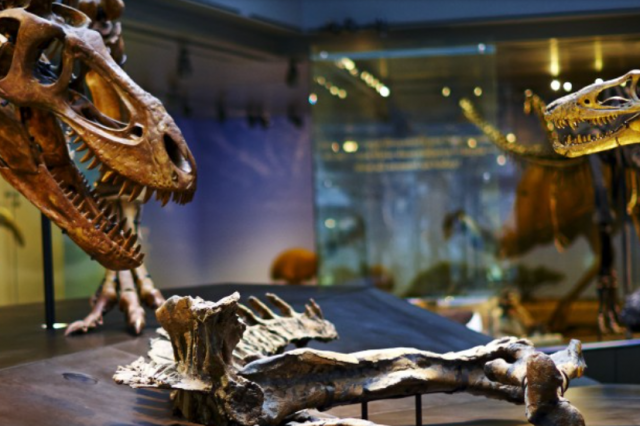
Learn More
Solve rhyming clues to figure out which adaptations helped dinosaurs survive in their habitats.
Animals throughout time have developed special traits in order to better survive in their habitats. This lesson explores adaptations for the prehistoric animals of the Museum’s Dinosaur Hall and draws comparisons to living animals. Students will solve rhyming clues to figure out which adaptations helped certain dinosaurs survive in their habitats.
See Learning Standards at the bottom.
Guide students in a discussion of how physical adaptations help animals survive, and create a Then & Now T-Chart comparing adaptations in animals now (extant animals) versus animals then (extinct animals). At the Museum, have students use the Dinosaur Clues Worksheet to explore the Dinosaur Hall and discover different adaptations. After the activity, students will reflect and add any additional information to the T-Chart.
Pre-Activity
Before your time with students, find several images of animals in their habitats to share. These images can be extant (still living) animals, as well as extinct (no longer living) animals, including dinosaurs. For comparison purposes, try to find pictures of extant animals that have adaptations similar to those of the dinosaurs (e.g. a tiger and a T-rex with big sharp teeth for eating meat, or a whale and a mosasaur with flippers for swimming in the ocean) . With your students, review the concept that animals have adaptations that allow them to survive in their habitats. An adaptation is a trait that changes over time to help an animal survive better in its habitat. Show students the pictures of extant animals in their habitats. Ask them to point out traits and come up with ideas about how the animal might use a certain trait to survive in its home. Record ideas under the ’Animals Now’ column of a Then & Now T-Chart (see example below). This can be done as a class, or, if there are enough pictures, in groups before sharing with the class. Remind students that animals have more than one adaptation! Next, explain that we use knowledge of living animals to help us understand extinct animals, like dinosaurs. Repeat the activity above with the dinosaur pictures, recording ideas in the ‘Animals Then’ column. As you go (or after a list has been generated) ask students to compare adaptations they saw in the extant animals with those that they saw in the extinct animals. Might similar features have similar functions?
Example Then & Now T-Chart
Activity
Distribute the Dinosaur Clues Worksheet and explain that, like they did before, they are going to look for adaptations. While exploring the Dinosaur Hall, have students read the clues (with help from chaperones when needed) in order to find the corresponding adaptation and name the dinosaur it goes along with. Note that there can be more than one correct answer per clue, and that multiple dinosaurs may share the same adaptation.
Post-Activity
Go through the worksheet and discuss the students’ answers, clarifying information or asking them to expand on ideas when necessary. Add further observations to the T-Chart. Like before, ask students if they can think of living animals that have similar adaptations, and add those to the chart, too. You may choose to have students complete a culminating project demonstrating their understanding of the concept.
Variations & Extensions
NGSS
1-LS1-1, 1-LS1-2
SEPs
Obtaining, Evaluating, and Communicating Information
Scientific Knowledge is Based on Empirical Evidence
DCIs
LS1.A: Structure and Function
CCCs
Patterns
Structure & Function
ELA
RI.1.1